Providing tomatoes with good and balanced nutrition during growth and development, you can get a plentiful tomato crop. With the wrong application of fertilizing, tomatoes weaken, are easily amenable to diseases, yield indicators are lost. Overfeeding plants threatens the intensive growth of tops, and the fruits are poorly developed, the bushes will be susceptible to late blight.
Content
How to feed tomatoes
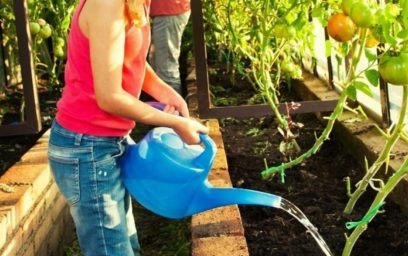 When feeding a tomato, it is necessary to take into account the growth phase of the tomato, introducing those elements that are necessary for the plant in this period. Before flowering, tomatoes require nitrogen-phosphorus fertilizers, during flowering - nitrogen-potassium fertilizers.
When feeding a tomato, it is necessary to take into account the growth phase of the tomato, introducing those elements that are necessary for the plant in this period. Before flowering, tomatoes require nitrogen-phosphorus fertilizers, during flowering - nitrogen-potassium fertilizers.
There is an approximate scheme for introducing nutrients for tomato seedlings (both in open areas and in polycarbonate greenhouses), consisting of six main stages that take into account the development cycles of tomatoes.
Before planting in the ground
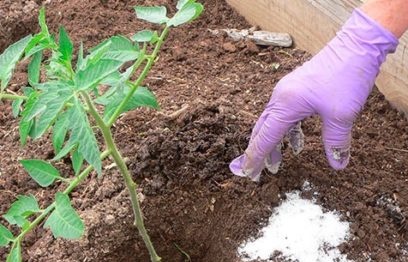 7-15 days before the bushes are planted in the ground (usually in May), nitrogen-phosphorus fertilizers are applied to the soil, the recommended dose is 30-40 g / sq.m. If organic fertilizers have already been applied, then adjust the dose depending on what has already been given.
7-15 days before the bushes are planted in the ground (usually in May), nitrogen-phosphorus fertilizers are applied to the soil, the recommended dose is 30-40 g / sq.m. If organic fertilizers have already been applied, then adjust the dose depending on what has already been given.
Directly during planting, you should add a small portion of potash fertilizers.
A couple of weeks after landing
After a period of adaptation to new conditions, bushes for good growth and development require not only nitrogen and phosphorus, but also other trace elements:
- potassium;
- calcium;
- magnesium (sulfate or nitrate).
Of the magnesium species, it is preferable to use magnesium nitrate, it already contains nitrogen. In this case, nitrogen fertilizer does not need to be added. If the condition of the seedlings requires earlier feeding, you should not wait 2 weeks - it is better to feed early, and after a while - one more time.
During growth
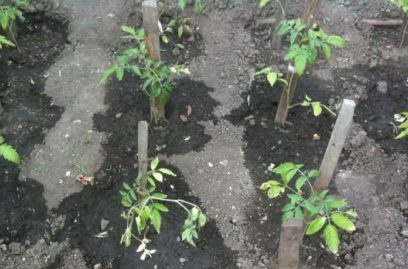 When entering the active growth cycle, tomatoes also require phosphorus to develop the root system and nitrogen, which helps plants develop stems and leaves. In this period, no more than two top dressings are carried out.
When entering the active growth cycle, tomatoes also require phosphorus to develop the root system and nitrogen, which helps plants develop stems and leaves. In this period, no more than two top dressings are carried out.
During flowering
Spend 2 - 3 root dressing with potassium-phosphorus fertilizers, aimed at tying berries. With a deficiency of potassium and phosphorus, the flowers do not pollinate, fall off and yield decreases.
Nitrogen from this moment is minimized or canceled (the decision is made by looking at the state of greenery of tomato seedlings) so that the plants direct power to flowering and crop development.
At the stage of fruit set
Phosphorus and potassium is the main nutrition of tomatoes, the number of fertilizers per period: 2 - 3. You can refuse from nitrogen.
There are many complex preparations for use during fruit setting, but the safest ones are organic.
During fruiting
 Tomatoes are fed 2-3 times for a better taste of the fruit and quick ripening. Along with phosphorus, it is necessary to:
Tomatoes are fed 2-3 times for a better taste of the fruit and quick ripening. Along with phosphorus, it is necessary to:
- potassium;
- iodine;
- manganese;
- boron.
With this feeding, the ripened fruits will be fleshy and sweet.
Two weeks before harvesting, you must stop feeding the plants.
Extraordinary top dressing tomato
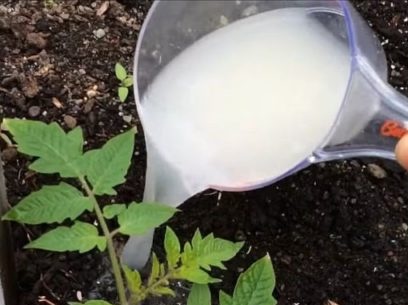 The number of top dressings depends on the development of seedlings and the state of the soil. If the plants look unhealthy, which indicates a lack of nutrients, then an extraordinary procedure for feeding tomatoes should be carried out. Also add fertilizers when planting it is not necessary to soil if seedlings have been fed before planting. With good indicators of plant growth at any stage, it is not necessary to follow the described scheme, performing exactly all the fertilizing. With the magnificent health of the bushes at any stage, the next top dressing indicated in the diagram above can be skipped.
The number of top dressings depends on the development of seedlings and the state of the soil. If the plants look unhealthy, which indicates a lack of nutrients, then an extraordinary procedure for feeding tomatoes should be carried out. Also add fertilizers when planting it is not necessary to soil if seedlings have been fed before planting. With good indicators of plant growth at any stage, it is not necessary to follow the described scheme, performing exactly all the fertilizing. With the magnificent health of the bushes at any stage, the next top dressing indicated in the diagram above can be skipped.
Fertilizing tomatoes grown in separate containers is carried out according to the described scheme, and at the request of plants supplemented with fertilizers out of turn, since the soil in a limited space quickly depletes.
Topping tomatoes in a greenhouse
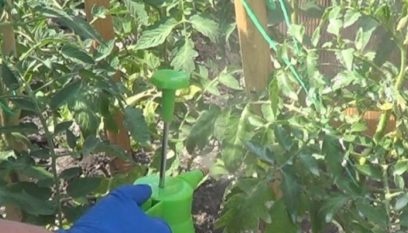 For tomatoes growing in a greenhouse, the above scheme must be maintained, since in the bulk earth of boxes and greenhouses the circulation of nutrients is less active than in open ground.
For tomatoes growing in a greenhouse, the above scheme must be maintained, since in the bulk earth of boxes and greenhouses the circulation of nutrients is less active than in open ground.
Extra root treatments can be added to the main top dressing of the roots. Spraying the leaves with nutritious mixtures can be carried out before the flowering period. The foliar method of top dressing is very effective; tomatoes absorb it almost 100%. Leaf processing strengthens the immunity of the plant, increases the yield of bushes. Spraying is carried out no more than 2 times per season, alternating them with root “feedings”. For processing by leaves, a concentrated solution is not needed, 0.1-0.15% is enough.
The total number of fertilizing greenhouse tomatoes per season (after planting in the ground) can be carried out up to 8-10 times. Despite the good absorption of nutrients by the leaves of plants, top-dressing is often not necessary, since they do not like the increased humidity of the tops and stems of the tomato. If the bushes did not respond to foliar application, it is better to additionally fertilize. With normal growth and development of tomato seedlings, you don’t need to fertilize them too much, you should not overfeed this culture, it is better to underfeed.
Properly preparing the soil before planting, it may be necessary to start top dressing with a flowering period. The development and condition of the bush will help to navigate the need for its implementation.
How to feed tomato bushes
Tomato seedlings grow well on soil fertilized with tomato tops last fall:
- gather greenery of healthy plants, dry, grind;
- fall asleep in the ground.
There are many inexpensive and affordable means for fertilizing plantings of tomatoes.
At the first feeding after planting, you can fertilize so: a tablespoon of nitrophosphate, half a liter of water infused on mullein, 1 - 2 tablets of fertilizer containing trace elements, 5 grams of boric acid add to 10 liters of water. Water 1 liter of mixture per bush.
For the second top dressing, use a similar recipe, replacing the nitrophosk with potassium sulfate.
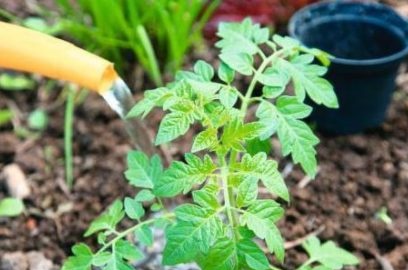 For foliar treatment, you can use:
For foliar treatment, you can use:
- non-concentrated boric acid - dissolve 10 g of powder substance in 10 l of water, carry out the treatment when the second and third brushes bloom;
- potassium nitrate - pour a teaspoon to 10 liters of water;
- monophosphate - 5 grams add to 10 liters of water;
- urea - dilute a teaspoon in 10 liters of water;
- serum - add 1 liter to a bucket of water. serum and 20 drops of iodine.
You can use these solutions alternately, or one of the specified, with the required frequency.
Folk recipes for feeding tomatoes
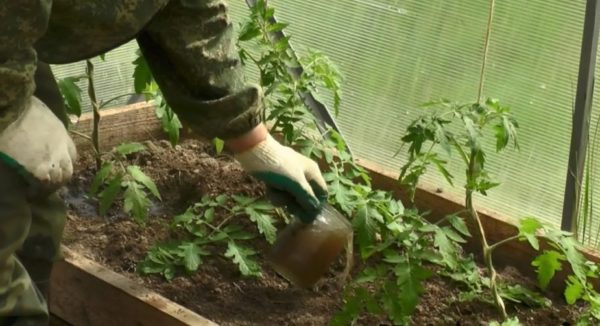 Organic Organic Fertilizers, loved by gardeners, are not inferior in effectiveness to ready-made chemical ones.When used, tomatoes also bear fruit well and delight the owners, giving confidence in their natural origin.
Organic Organic Fertilizers, loved by gardeners, are not inferior in effectiveness to ready-made chemical ones.When used, tomatoes also bear fruit well and delight the owners, giving confidence in their natural origin.
- Add a bucket of water 8 drops of iodine solution, pour 1 liter under a bush.
- Dilute chicken droppings with water: fill a third of the bucket with fertilizer, add water to the edges, close tightly (nitrogen is a volatile substance), insist 1 - 1.5 weeks, stirring daily. When watering, add half a liter of this tincture to the bucket and water between the rows per 1 sq.m. - from 5 to 6 liters.
- Mullein fertilizer should be prepared as follows: fill the half of the tank with manure, add water to the edges, cover with a lid and leave it warm for about a week. Then mix everything. To water, diluting 1:10 with water, using 0.5 - 1 liter per bush.
- Young nettle (dandelion, alfalfa) fill 2/3 of the volume of the vessel, add water, leaving a little space, close and leave warm for 7 to 10 days before fermentation. Watering, breeding 1:10, on a plant up to 2 liters. Conduct no more than 2 feeding nettle per month.
- 2 - 3 pcs. banana skins (they have a lot of potassium), place in a 3-liter container, fill with warm water, insist for 3 days, strain and infuse the seedlings with tincture.
- Grind eggshells 3 - 4 eggs, pour 3 liters of warm water, cover loosely and put in a dark place for three days. The infusion should become cloudy and smell unpleasant (consequences of decomposition of hydrogen sulfide). Pour tomatoes with this infusion.
At the stage of fruiting tomatoes, the following recipes are recommended:
- Moisten the soil and sprinkle dry ash on it: 3-5 tbsp. on 1 sq.m. - can be used throughout the season no more often than 2 weeks from the previous feeding; ash will add sweets to the berries.
- Prepare the mineral mixture: pour ash of two liters of 5 liters of boiling water, cool, add water to 10 liters and add 10 ml of iodine, use, adding it to the water for watering 1:10, 1 liter is enough for the bush.
- Live yeast - a piece weighing 100 g is put in a 3-liter container, pour 0.5 tbsp. granulated sugar, fill with water (37 degrees) to the top. Put for fermentation in heat, shake periodically. Dilute 1 cup of the finished substrate with 10 liters of water. Water each bush with 1 liter of the mixture; this technique is enough to use 1 time during the season, as there are no nutrients in the yeast, it is rather a growth stimulator.
Also, for gardening, land treatment and watering, many gardeners use ammonia.
In order not to overfeed the tomato seedlings
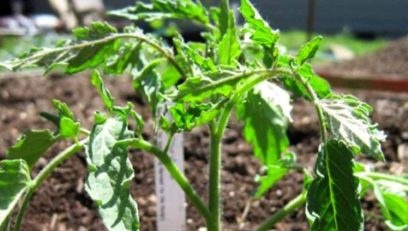 Abundantly organic soil is contraindicated in tomato seedlings, do not add manure or bird droppings to the pits during planting - the bushes will fatten, bear fruit poorly, and begin to hurt.
Abundantly organic soil is contraindicated in tomato seedlings, do not add manure or bird droppings to the pits during planting - the bushes will fatten, bear fruit poorly, and begin to hurt.
Do not feed the plants with mullein tincture more than two to three times per season.
Excessive urea top dressing also has a negative effect on tomato yields. It is better not to put it when planting in the pit to the roots of plants and not to produce frequency watering with a solution of urea of tomato seedlings, but to produce sheet top dressing with it at the initial stage of seedling growth.
Excess nutrients and moisture create conditions for growing green bushes and delay ripening of berries. Friendly ripening of the tomato occurs on "thin" soil, and not on "greasy".
Having studied the rules top dressing tomato, you can make a plan for fertilizing plants. But, during the growth of the bushes, you need to watch them. You may have to adjust the circuit.




 Low-growing tomatoes, without pinching: 5 of the most delicious varieties
Low-growing tomatoes, without pinching: 5 of the most delicious varieties Why tomato seedlings grow poorly
Why tomato seedlings grow poorly We grow a tomato in a shell
We grow a tomato in a shell Growing tomatoes without watering according to the method of Kazarin
Growing tomatoes without watering according to the method of Kazarin
hope
In general, it’s as if written well. But it would be much clearer if, by indicating the useful substances necessary for fertilizing, you called the fertilizer “products” yourself, for example: nitrogen - ash, potassium - manure, calcium - eggshell, etc.